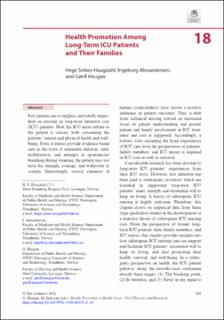| dc.description.abstract | Few patients are as helpless and totally dependent on nursing as long-term intensive care (ICU) patients. How the ICU nurse relates to the patient is crucial, both concerning the patients’ mental and physical health and well-being. Even if nurses provide evidence-based care in the form of minimum sedation, early mobilization, and attempts at spontaneous breathing during weaning, the patient may not have the strength, courage, and willpower to comply. Interestingly, several elements of human connectedness have shown a positive influence on patient outcomes. Thus, a shift from technical nursing toward an increased focus on patient understanding and greater patient and family involvement in ICU treatment and care is suggested. Accordingly, a holistic view including the lived experiences of ICU care from the perspectives of patients, family members, and ICU nurses is required in ICU care as well as research.
Considerable research has been devoted to long-term ICU patients’ experiences from their ICU stays. However, less attention has been paid to salutogenic resources which are essential in supporting long-term ICU patients’ inner strength and existential will to keep on living. A theory of salutogenic ICU nursing is highly welcome. Therefore, this chapter draws on empirical data from three large qualitative studies in the development of a tentative theory of salutogenic ICU nursing care. From the perspective of former long-term ICU patients, their family members, and ICU nurses, this chapter provides insights into how salutogenic ICU nursing care can support and facilitate ICU patients’ existential will to keep on living, and thus promoting their health, survival, and well-being. In a salutogenic perspective on health, the ICU patient pathway along the ease/dis-ease continuum reveals three stages; (1) The breaking point, (2) In between, and (3) Never in my mind to give up. The tentative theory of salutogenic long-term ICU nursing care includes five main concepts: (1) the long-term ICU patient pathway (along the salutogenic health continuum), (2) the patient’s inner strength and willpower, (3) salutogenic ICU nursing care (4), family care, and (5) pull and push. The salutogenic concepts of inner strength, meaning, connectedness, hope, willpower, and coping are of vital importance and form the essence of salutogenic long-term ICU nursing care. | en_US |

